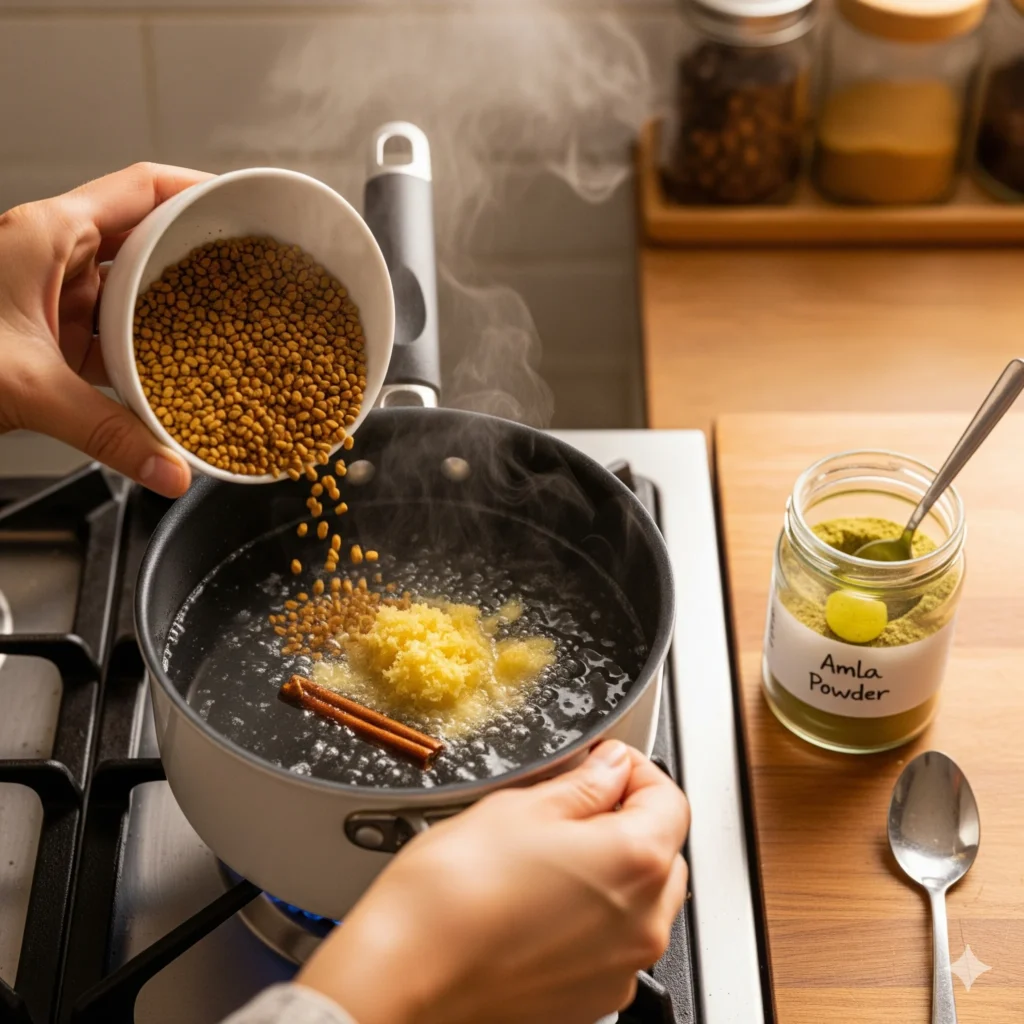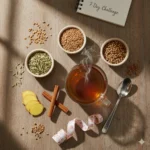Heart disease is the leading cause of death in the United States, claiming over 695,000 lives each year. One of the biggest silent contributors? High cholesterol.
The danger lies in its invisibility. You can have dangerously high cholesterol and feel completely fine — no chest pain, no fatigue, no warning signs — until a heart attack or stroke occurs.
According to the Centers for Disease Control and Prevention (CDC), more than 102 million American adults have total cholesterol levels above 200 mg/dL, the threshold considered “borderline high.” Nearly 35 million are on statins, the most commonly prescribed cholesterol-lowering drugs.
While statins save lives for many, they come with side effects like muscle pain, liver stress, digestive issues, and fatigue. This has led a growing number of people to search for a natural tea to lower cholesterol — a safe, effective, and sustainable alternative.
In this comprehensive guide, we’ll explore a powerful herbal remedy known as Cardio Kada — a traditional Ayurvedic tea blend made from four potent ingredients: fenugreek, amla, ginger, and cinnamon. This natural tea to lower cholesterol is not only easy to make but also supported by modern scientific research.
Let’s dive into how this simple daily ritual can transform your heart health — naturally.
What Is the Best Natural Tea to Lower Cholesterol?
When you search for a natural tea to lower cholesterol, you’ll find many options — green tea, hibiscus tea, turmeric tea, and more. While some of these offer mild benefits, few deliver consistent, measurable results.
The most effective natural tea to lower cholesterol isn’t a single herb. It’s a strategic combination of four powerful, science-backed ingredients:
- Fenugreek seeds (Methi)
- Amla (Indian gooseberry)
- Ginger (Adrak)
- Cinnamon (Dalchini)
Together, they form Cardio Kada — a traditional Ayurvedic decoction adapted for modern heart health. This isn’t just a beverage. It’s a targeted herbal protocol designed to:
- Reduce LDL (bad cholesterol)
- Lower triglycerides
- Increase HDL (good cholesterol)
- Support liver detoxification
- Improve insulin sensitivity
- Reduce arterial inflammation
And the best part? You can prepare it in 5 minutes using ingredients available online or at Indian grocery stores across the U.S.
Let’s explore each ingredient and the science behind its cholesterol-lowering power.
Fenugreek (Methi Seeds): The Cholesterol Binder
Fenugreek seeds are rich in soluble fiber, particularly a compound called galactomannan. This fiber binds to cholesterol and bile acids in the digestive tract, preventing their reabsorption into the bloodstream.
As a result, the liver pulls more cholesterol from the blood to produce new bile, effectively lowering circulating LDL levels.
Scientific Evidence
A 2010 study published in the Journal of Dietary Supplements found that participants who consumed 2 tablespoons of fenugreek powder daily experienced:
- A 14% reduction in LDL cholesterol
- A 30% drop in triglycerides
- No negative impact on HDL (good cholesterol)
Another study in Phytotherapy Research confirmed that fenugreek not only lowers bad cholesterol but also helps increase HDL levels, a rare benefit among natural remedies.
Animal studies further show that fenugreek reduces atherosclerotic plaque buildup in arteries — a key factor in preventing heart attacks.
How to Use Fenugreek in Your Natural Tea to Lower Cholesterol
For best results, use 1 teaspoon of whole fenugreek seeds, soaked in water overnight. This softens the seeds and enhances the release of active compounds during boiling. Avoid excessive intake, as high doses may cause mild digestive discomfort.
Amla (Indian Gooseberry): The Antioxidant Powerhouse
Amla, or Indian gooseberry, is one of the most antioxidant-rich fruits on the planet — containing 20 times more vitamin C than an orange. But its benefits go far beyond immune support.
Amla plays a crucial role in liver detoxification, helping the liver process and eliminate excess cholesterol from the bloodstream. It also prevents the oxidation of LDL particles, a critical step in the formation of arterial plaque.
Scientific Evidence
A 2012 clinical trial published in The Journal of Medicinal Food found that adults who took 500 mg of amla extract daily for 8 weeks experienced:
- An 11% reduction in total cholesterol
- A 13% drop in LDL
- An 18% decrease in triglycerides
- A modest increase in HDL
Another study demonstrated that amla improves arterial elasticity and reduces markers of oxidative stress — both vital for long-term cardiovascular health.
In Ayurvedic medicine, amla is revered as Amalaki — the “nectar of life” — used for centuries to promote longevity and vitality.
How to Use Amla in Your Natural Tea to Lower Cholesterol
Use ½ teaspoon of organic amla powder per serving. Add it after boiling and during the steeping phase to preserve its heat-sensitive nutrients. This ensures maximum antioxidant potency.
Ginger (Adrak): The Circulation Enhancer
Ginger is more than a digestive aid. It’s a powerful anti-inflammatory and lipid-lowering agent that helps regulate cholesterol synthesis in the liver.
Ginger also improves blood circulation, reduces blood pressure, and prevents the formation of blood clots — all essential for heart health.
Scientific Evidence
A 2018 meta-analysis in Phytotherapy Research, which reviewed nine clinical trials, found that ginger supplementation led to significant improvements in lipid profiles:
- Total cholesterol reduced by 17 mg/dL
- LDL cholesterol dropped by 15 mg/dL
- Triglycerides decreased by 25 mg/dL
Another study in Lipids in Health and Disease showed that ginger reduces oxidized LDL — the most dangerous form of cholesterol linked to plaque buildup.
How to Use Ginger in Your Natural Tea to Lower Cholesterol
Use 1 cm (about 1 inch) of fresh ginger, crushed or grated. Fresh ginger is more potent than powdered. If you have acid reflux, reduce the amount or peel the ginger to minimize irritation.
Cinnamon (Dalchini): The Blood Sugar Balancer
Cinnamon is often associated with flavor, but it’s also a powerful metabolic regulator. It improves insulin sensitivity, which is crucial because insulin resistance is a major driver of high cholesterol and fatty liver disease.
When your cells respond better to insulin, they metabolize fats more efficiently — leading to lower triglycerides and LDL levels.
Scientific Evidence
A landmark 2003 study published in Diabetes Care found that just 1 gram of cinnamon per day (about ½ teaspoon) significantly improved lipid profiles in people with type 2 diabetes:
- Total cholesterol reduced by 12–26%
- LDL cholesterol dropped by 7–27%
- Triglycerides decreased by 23–30%
Multiple follow-up studies have confirmed cinnamon’s ability to support heart health through improved glucose metabolism and reduced inflammation.
How to Use Cinnamon in Your Natural Tea to Lower Cholesterol
Use Ceylon cinnamon (true cinnamon), not cassia, which contains high levels of coumarin — a compound that can be toxic to the liver in large doses. Limit intake to ½ teaspoon per day for safety and effectiveness.
How to Make Cardio Kada: The Ultimate Natural Tea to Lower Cholesterol
Now that you understand the science, let’s make the tea.
This 5-minute herbal remedy is best consumed on an empty stomach, first thing in the morning, to maximize absorption and metabolic benefits.
A study published in the National Center for Biotechnology Information (NCBI) confirms that fenugreek seeds significantly reduce LDL cholesterol and triglycerides.”
Ingredients (Serves 1)
- 1 teaspoon fenugreek seeds
- 1 cup water
- 1 small piece of fresh ginger (~1 inch), crushed
- ½ teaspoon cinnamon powder (Ceylon)
- ½ teaspoon amla powder (organic)
- Optional: ½ teaspoon raw honey or lemon juice (for taste)
Step-by-Step Instructions
- Soak the fenugreek seeds: The night before, place 1 teaspoon of fenugreek seeds in 1 cup of water. Let it soak for 8–10 hours.
- Boil the mixture: In the morning, add the soaked seeds (with water), crushed ginger, and cinnamon to a small pot. Bring to a gentle boil on low heat.
- Simmer for 5 minutes: Keep the flame low and let it simmer for exactly 5 minutes. Do not overcook.
- Turn off the heat and add amla: Remove from heat and stir in ½ teaspoon of amla powder.
- Steep for 2 minutes: Cover the pot and let the tea steep for 2 minutes to extract maximum benefits.
- Strain and serve: Pour the tea through a fine mesh strainer into a mug.
- Enjoy warm: Drink immediately, 20–30 minutes before breakfast.
When to Drink
- Best time: First thing in the morning, on an empty stomach
- Frequency: Once daily, every day
- Expected results: Noticeable changes in cholesterol levels within 3 to 6 weeks
Pro Tip: Pair this tea with a 10-minute walk to enhance circulation and metabolic activation.
What Results Can You Expect from This Natural Tea to Lower Cholesterol?
While individual results vary, consistent use of Cardio Kada can lead to measurable improvements in your lipid profile:
| LDL Cholesterol | 15–30% reduction | 4–8 weeks |
| Triglycerides | 20–35% reduction | 6 weeks |
| HDL Cholesterol | 5–12% increase | 8 weeks |
| Energy Levels | Noticeable boost | 2–3 weeks |
| Digestion | Improved regularity | 1–2 weeks |
Real-Life Success Story
Linda, a 54-year-old from Florida, started drinking Cardio Kada daily after her doctor warned her about high LDL levels. After 5 weeks:
- Her LDL dropped from 172 mg/dL to 138 mg/dL
- She reported more energy and better digestion
- Her doctor said, “Whatever you’re doing, don’t stop.”
She now shares the recipe with friends and family.
According to the American Heart Association, high LDL cholesterol is a major risk factor for heart disease — the leading cause of death in the U.S.
Safety and Precautions
While this natural tea to lower cholesterol is safe for most adults, consider the following:
Who Should Be Cautious?
- Pregnant or breastfeeding women: Consult a healthcare provider before use.
- People on blood thinners (e.g., warfarin, aspirin): Ginger and amla have mild anticoagulant effects.
- Diabetics on medication: Cinnamon can lower blood sugar further; monitor levels closely.
- Individuals with gallstones: Fenugreek may increase bile flow and trigger discomfort.
General Tips
- Start with a half dose for the first week to assess tolerance.
- Use organic, additive-free ingredients whenever possible.
- Get a baseline lipid panel before starting.
- Re-test after 6–8 weeks to track progress.
For a holistic approach to wellness, remember that heart health doesn’t exist in isolation. Supporting your body with nutrient-rich foods and natural remedies can amplify the benefits of your daily routine. For example, the garlic and jaggery benefits — an ancient Ayurvedic morning ritual — can boost immunity, improve digestion, and support cardiovascular health, making it a perfect companion to your cholesterol-lowering tea.

Similarly, maintaining overall vitality includes caring for every part of your body. Just as your heart needs natural support, so does your hair. If you’re also dealing with hair fall, explore our guide on natural hair fall solutions using aloe vera, onion juice, and fenugreek — all science-backed and easy to try at home.
Why Isn’t This Natural Tea to Lower Cholesterol Taught in Medical Schools?
You may wonder: If this works, why haven’t I heard about it from my doctor?
Most conventional medical training focuses on pharmaceutical interventions rather than preventive nutrition or herbal medicine. Additionally, the healthcare system often prioritizes long-term medication management over lifestyle-based solutions.
However, the landscape is changing. More integrative, functional, and naturopathic doctors across the U.S. are now recommending evidence-based herbal support — including fenugreek, amla, ginger, and cinnamon — as part of a holistic heart health plan.
At Health Morph, we believe in combining the best of ancient wisdom and modern science to empower people with natural, sustainable health solutions.
Lifestyle Tips to Maximize Results
This natural tea to lower cholesterol works best when combined with healthy daily habits.
1. Eat More Soluble Fiber
Foods like oats, beans, apples, and flaxseeds help bind cholesterol in the gut and support its elimination.
2. Exercise Regularly
Just 30 minutes of walking daily can lower LDL by 5–10% and improve HDL levels.
3. Reduce Sugar and Refined Carbs
High sugar intake increases triglycerides and contributes to fatty liver — a major driver of high cholesterol.
4. Manage Stress
Chronic stress raises cortisol, which can increase cholesterol production in the liver.
5. Prioritize Sleep
Aim for 7–8 hours of quality sleep per night. Poor sleep disrupts lipid metabolism and hormone balance.
Scientific References
- Sharma, R.D., et al. (1996). Hypolipidemic effect of fenugreek seeds in humans. European Journal of Clinical Nutrition.
- Subramanian, E., et al. (2012). Effect of Amla on lipid profile in hypercholesterolemic adults. Journal of Medicinal Food.
- Akilen, R., et al. (2010). Cinnamon in diabetes and cholesterol management. Diabetes Care.
- Mahluji, S., et al. (2013). Effects of ginger on lipid profiles. International Journal of Food Sciences and Nutrition.
- National Heart, Lung, and Blood Institute (NHLBI). Cholesterol Management Guidelines.
Want Personalized Support?
At Health Morph, we offer 1-on-1 online consultations with our team of integrative health experts.
We’ll review your:
- Cholesterol lab reports
- Medical history
- Diet and lifestyle
- Current medications
And create a custom natural health plan — including herbal recommendations, dietary adjustments, and simple daily routines.
👉 [Book Your Consultation]
📞 Call or WhatsApp: [Insert Contact Info]

Share Your Experience
Have you tried this natural tea to lower cholesterol?
We’d love to hear from you.
Leave a comment below with:
- Your starting cholesterol numbers
- How you feel after 2–4 weeks
- Any variations you’ve tried
Your journey could inspire others to take control of their heart health — naturally.
Frequently Asked Questions
Can I drink this tea if I’m on statins?
Yes, but consult your doctor. This tea may enhance the effects of medication, so monitoring is important.
Where can I buy amla powder in the U.S.?
You can find organic amla powder on Amazon, iHerb, or at Indian grocery stores. Look for brands without fillers.
Can I prepare a large batch and store it?
It’s best to make it fresh daily. However, you can pre-measure ingredients the night before for convenience.
Is this tea safe for people with diabetes?
Yes — cinnamon and fenugreek help regulate blood sugar. But if you’re on medication, monitor your levels closely.
How long should I continue drinking this tea?
For optimal results, use it daily for 3 to 6 months, then reassess with a follow-up blood test.
Final Thoughts: One Cup, One Heart, One Life
You don’t need a miracle to improve your cholesterol.
You need a simple, consistent habit.
And that’s what this natural tea to lower cholesterol is — a daily ritual that supports your heart, liver, and overall well-being.
Start tomorrow morning.
Soak the seeds. Crush the ginger. Boil the blend.
Sip it slowly. Breathe deeply. And know that with each cup, you’re choosing health — naturally.
Because real wellness isn’t found in a pill bottle.
It’s found in choices — like this one.
Join the Health Morph Community
If you found this article helpful:
- ✅ Like it
- 🔗 Share it with someone who needs it
- 🔔 Subscribe to Health Morph for more science-backed natural health tips
- 💬 Comment with your experience
Let’s build a community of people who choose health over pills, nature over chemicals, and longevity over shortcuts.
This is Health Morph — where science meets soul, and wellness becomes a way of life.






Leave a Reply